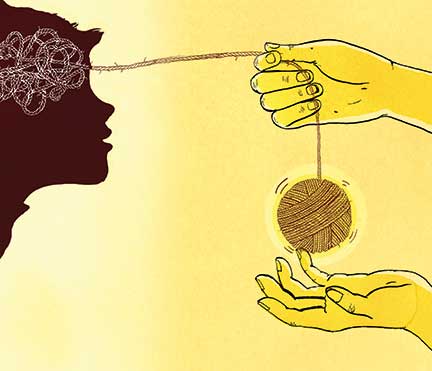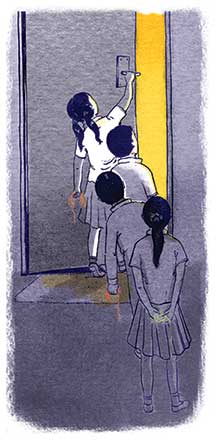Lakshmi Karunakaran
Over the years there has been an alarming rise in mental health disorders in the country. According to a study conducted by the National Commission on Macroeconomics and Health in 2005, nearly five per cent of India’s population suffers from common mental disorders, such as depression and anxiety. Children make a considerable chunk of that number. They have been at the receiving end of many socio-economic changes that our society has seen in the recent past – the breakdown of the joint family, peer and parental pressure, pressure of academic performance, sudden advancement in technology, and the need to ‘fit in’ has multiplied their risks of stress, depression and other mental illnesses.
Given this, the Central Board of Secondary Education (CBSE) has specified the appointment of one counsellor in each of its affiliated schools. While the mental health community has welcomed this decision, schools on the ground are facing the dearth of trained professionals. What adds to the problem is the lack of understanding of the role of counsellors in school.
 Role of a counsellor
Role of a counsellor
According to the Indian Institute of School Psychology*, school counselling is a profession which: i. aims primarily to improve the academic performances of the students. ii. provides vocational guidance. iii. helps in social and personal development of the students. iv. provides the much needed bridge between parents and students. v. functions in preventive, remedial and developmental modes. vi. functions to remove barriers to development if any, in the individual or in the environment. vii. works to identify, assess , evaluate, solve or refer, if necessary, problems of students which may be behavioural, emotional, social, academic or psychological. viii. Involves the team efforts of the teachers, the parents and other school staff.
While this definition seems comprehensive, schools have not yet been able to orient themselves to accommodate such a complex role in the system. Maullika Sharma, counsellor at The Reach Clinic, Bangalore, working largely with adolescents and young adults agrees “Schools in most cases are unable to utilize their counsellors. That is largely because there is a lack of understanding of the counsellor’s role. Most counsellors land up being just another teacher and are often burdened with teaching, arts and crafts, and admin work, because the school administration feels that the counsellor has no substantial work.”
Maullika believes that the counsellor, through his/her work in the school needs to engage with all three characters of the triad – child, parent and teacher, to be able to address the larger mental health needs of the school substantially. “Parents are often confused when they are unable to understand a child’s behaviour and if abnormal behaviour persists they don’t know where to go and whom to turn to. When they are faced with diagnosis of mental illness for their child, they don’t understand the implications and often don’t know how to react or respond to best support their child. They are often overwhelmed with their own anxieties and pressures that they are unable to be available for their child when their child needs them most. Teachers, like the rest of us, maybe struggling with life’s challenges as well. In giving them access to a safe space, the chances that they will carry the impact of their life’s struggles into their classrooms are reduced. It is important to help teachers deal with their emotional baggage so that they can be more emotionally available to the students they teach. Also, counselling helps them understand the impact of their words and actions on the lives that they are helping shape.”
Teachers, who for decades have remained informal counsellors at school, feel the pressures and demands of the current educational system, and the socio-economic changes equally. White Swan Foundation (WSF), a not-for-profit organization that offers knowledge services in the area of mental health is currently involved in a project that caters to the mental health and wellbeing of anganwadi teachers. Patrecia Preetham, who manages outreach programs at WSF says, “Anganwadi teachers work with young mothers, children and teenage girls. Our initial survey for the project showed that they knew very little about mental wellness. While our primary objective was to educate the teachers about being able to inform and counsel the children and parents on their mental well-being, we realized that most anganwadi teachers themselves need help. Many came from battered families, and faced domestic violence and distress in their own homes. Since then addressing the mental health needs of the anganwadi workers has become a key element of the project.”
Reaching out
The counsellor is an expert who addresses a specific area in the school system. While it is important for counsellors to be ‘different’ from other teachers at the school, it is equally important that they are visible and accessible to students. “It is important that students understand what issues to approach the counsellor for and how to seek help. Confidentiality is key. They must come to believe that if they visit the counsellor with a problem, the other teachers, or the principal, or their parents, and most importantly, their peers will not come to know about it,” says Maullika. “For this, it is important for the counsellor to reach out to as many students personally. I would visit every classroom in their free period. I would educate them about various emotions, and how and why it is important to express them. And, emphasize on how I could help them. And after each of these classes, my diary used to be filled with appointments that the children scheduled. At the start of the academic year I would give a questionnaire to every child asking them to list out the kind of problems they are facing. The objective was not so much to get the children to respond, and most of them didn’t, but to make them aware of my presence and how and when they can seek help.” says Maullika.
Anita Rajah, Consultant, Clinical Psychologist with over two decades of experience, agrees and adds “I believe that confidentiality issues are linked to the larger atmosphere that the school system creates. If the school promotes an environment of friendship, openness, and trust, between the management, teachers and the students, this should not be a problem. If there is an authoritarian, punitive approach to the issue, then one observes the children of such schools shy away from approaching counsellors and getting help.”
 Teachers as counsellors
Teachers as counsellors
To fill in the large gap that exists between the demand for counsellors on the ground, and the number of trained professionals, there is a growing need for teachers themselves to be trained in counselling skills.
Anita believes that this is going to be the way forward.”Personally, I believe that all teachers need to be trained in counselling. The teacher is the first point of contact and probably has the most power over the child. So to some extent, the day to day problems and mentoring needs can be handled by them. If there is a problem that is repeated, and the teacher notices a pattern, then the teacher should have the judgment to refer the case to somebody who is more professional. More than often, that is the point of dispute – When do you refer? So a teacher may have helped a child overcome certain issues, been very supportive, but identifying that the problem is intense and the child needs professional systematic help, comes with training and experience. This is where an untrained teacher can slip.”
And the cost of such slips, like Maullika discovered, could be quite high. “A student with suicidal tendencies approached a teacher that she trusted. The teacher counselled her informally, and she felt she was able to handle the situation. She didn’t refer the child to a professional until one day it was too late”.
To have teachers who are trained to work with the school counsellors and have an understanding of the ambit of their own counselling work is crucial. “At any point about 30-40 per cent of the children in a school face some problem or the other. The ones that really require professional help are about five to seven per cent of the entire population. So in a school with a 1000 children, we are talking about 50-70 children who need expert help. This group definitely needs to be out of the ambit of the teacher,” adds Anita.
The larger question
As we diagnose children and label them in terms of their mental health and needs, there is a call to understand and investigate the larger issues that trigger such behaviour.
In a recent facebook post I read a query of a three year old’s mother who was contemplating taking a drop year for her child, but was extremely worried if that would affect his age considerations for his IAS entrance. This left me shocked and disturbed. Are these the kind of pressures and expectations that we are exposing our children to? At such an early age?
When I mention this to Anita, she says, “Regardless of academics there is a much larger social issue where children are being victimized. One is the lack of physical space. This means that there is no place for children to move around. They do not get enough opportunities to step out and breathe freely or move about freely. Because of which, some children who are more vulnerable tend to become more restless. There are others who have different paces of learning and are unable to catch up to what the school is teaching. And since the teaching method is uniform, the child loses interest and slips away, developing a secondary learning disability. A secondary learning disability is when children are unable to follow the instructions in class, for various reasons, and are not motivated or interested. They finally experience fatigue. All these are the children who get labelled. In most cases the school does not have an answer, the counsellor doesn’t have an answer and the parents definitely don’t have an answer. So we have a whole group of children who are being labelled continuously because of a system they are unable to fit into. There are very few schools that remain open to work with the children, and not against them. This I feel is the real issue”.
Even the Indian Institute of School Psychology’s definition of a counsellor, the primary focus is on “’to improve the academic performances of the students”’, while the larger need is to focus on the mental well-being of the students. The children’s access to help is still largely controlled by teachers and parents, who themselves are, in many cases, unequipped to handle such situations.
As we fill in positions of counsellors in our schools, it’s becoming important to ask: How are we going to respond to the needs of children in our school? How do we address the larger question of their mental health? What is the path will we take?
*International Research Journal of Social Sciences Vol 3.(3)
The author is an educator based in Bengaluru. She can be reached at lakshmikarunakaran@gmail.com.
